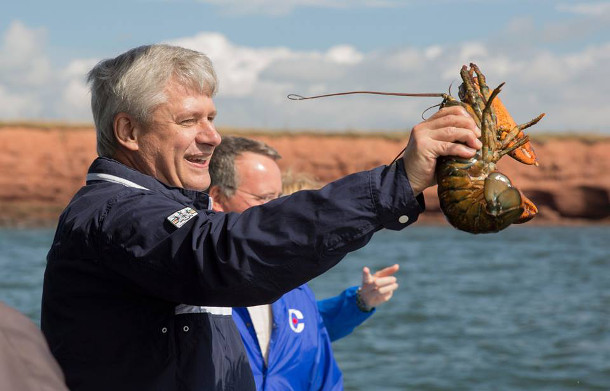In an email last week, Liberal leader Justin Trudeau asked for a million dollars.
As with countless other fundraising emails, he told supporters an important deadline was coming up at midnight, adding the money raised would help his party "grow our momentum" before "the biggest political rally in a generation."
We know major parties can spend up to $54.4 million over the course of 2015 election campaign -- more than in any other Canadian election, thanks to an early writ-drop. (That's about a million every 36 hours, for those keeping score at home.) Ridings can also spend a max of about $200,000, adding another $73 million to the election budget.
But on fundraising alone, the NDP, Liberals, Greens and Bloc all began this race tens of millions of dollars behind the Conservatives. Tories raised $20.1 million last year, with another $19 million spread out between riding associations. The Liberals raised $15 million, plus $8 million in the ridings. The NDP raised $9.5 million in 2014, and $4.4 million at the riding level. You get the idea.
Knowing this, you may wonder: what exactly happens to a seven-figure stack of political donations, particularly in the last weeks of a political campaign? Though we found no Elections Canada rules against buying fur coats or exotic pets, political strategists interviewed by The Tyee had some savvy insights into how parties are spending their money.
Skip the big ticket
Political parties spend hundreds of thousands of dollars producing political ads, and millions more blanketing airwaves across the country. Insiders say this is often a campaign's single biggest (and arguably most annoying) spend.
But at this stage in the race, political strategist and owner of Innovative Research Group, Greg Lyle, says smart parties will skip big-ticket ads in favour of local, targeted spending.
"For a variety of reasons I wouldn't put much into television," Lyle says, adding that national TV spots are often booked weeks ahead anyway. "A lot of people will see them who are not important to you."
Instead, Lyle says parties should use the final two weeks to parachute resources into a few-dozen swing ridings. "If you have a million, make sure that it's going to places that can make the difference."
Focus groups are also an early campaign investment -- one that Lyle doesn't recommend this late in the game. The cost of testing brand messages and ads on regular folks can range from $5,000 to $25,000 per group, or up to $80,000 for a series.
For a million you could book 100 groups in different cities and provinces -- asking them, for example, if they think a pipeline spill turning into a veiled woman's face is too "subtle."
Battleground polls
Polling research is another big spend, as parties track how candidates are performing in real time. A one-time single riding survey can cost as little as $1,500, depending on the sample size and number of questions. But more often parties pay for larger batches of research, ranging from $25,000 to $80,000 at a time. Polling more than 30 ridings for many weeks can total hundreds of thousands in the end.
Last election, the Conservative national office claimed it spent $369,000 on polling and research, while the Liberals and NDP spent $1 million and $1.5 million respectively. Then again, the Conservatives claimed an extra $2.3 million for "professional services" in 2011, a vague line item that amounted to just $320,000 for the other two parties combined.
But even polling has its limits in the final campaign countdown. By the last week, there's no longer time to reallocate resources to a tight race. On the whole, Lyle says, parties want to focus their last million "where the fight is." And that means plenty of travel and phone calls.
Over the course of a campaign, parties inevitably spend a few million on a leaders' tour from rally to rally. Strategists say travel can ramp up closer to election day.
Lyle notes that one of the most cost effective ways to sway a local riding is a telephone town hall. Party leaders or major players within a party will get on the phone with up to 1,000 voters to field questions. These can be done for an affordable $5,000 to $12,500.
"Phones are your very best last-minute tool," Lyle says. Voicemail drops from charismatic party leaders or candidates are also what Lyle calls "cheap dates," and such calls can "prime" voters on issues that party does best.
Riding re-ups
Thanks to Elections Canada caps on electoral district spending, you can't throw around a million dollars in one riding. But a little cash can go a long way.
According to a few candidate fundraising emails, $200 can buy one day of office rent; $100 covers meals for volunteers on E-day. Signs are $3 to $6 bucks each, direct mail flyers around 15 cents apiece. Strategists say competitive candidates spend $50,000 to $80,000 on lawn signs. (Much less if you're this guy.)
"What you're trying to do is get name recognition of the local candidate," Lyle says. "Sometimes they create a feeling of momentum, sometimes they carry a core ballot message."
But Lyle says in the final two weeks, it's too late for new lawn additions. Best to move on to identifying supporters and getting them to the polls on Oct. 19.
"There are two types of voters campaigns focus on. One is voters that support them," Lyle explains. "When four out of 10 people don't show up, the best bang for your buck is to take someone who's already a supporter and get them out on election day."
Bottom line: the closer you get to the end of an election campaign, the less parties spend on new voters, and the more they focus on the home team. It's a tactic Tyee columnist Bill Tieleman recently dubbed the "GOTV surprise."
But ultimately, strategists concede even a last-minute million won't buy your team a win. "A million buys you reach, and reach is good," Lyle says, "but it can't turn the thing around." ![]()
Read more: Politics, Election 2015
















Tyee Commenting Guidelines
Comments that violate guidelines risk being deleted, and violations may result in a temporary or permanent user ban. Maintain the spirit of good conversation to stay in the discussion.
*Please note The Tyee is not a forum for spreading misinformation about COVID-19, denying its existence or minimizing its risk to public health.
Do:
Do not: